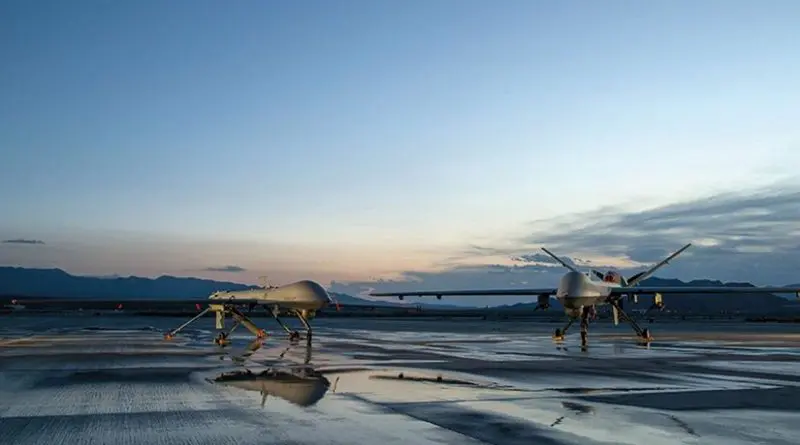The Debut Of Counter-Drone Technologies – Analysis
By Manohar Parrikar Institute for Defence Studies and Analyses (MP-IDSA)
By Vijay Sakhuja*
During his speech at the Munich Security Conference in February 2018, Israeli Prime Minister Benjamin Netanyahu “brandished” a piece of debris from an Iranian unmanned aerial vehicle (UAV) brought down by the Israeli military after it entered Israel’s airspace. Apparently, the Iranian UAV was a copy of the US’ ‘Sentinel’ that had been captured by Iran while on a reconnaissance mission in December 2011. By 2014, Iran had successfully reverse engineered the UAV and put it to operational use.
Earlier, ten fixed-wing drones strapped with small rockets were either destroyed or crash-landed by Russian forces while these were attempting to descend over air and naval bases in Syria. In the past, Russia has successfully destroyed Bayraktar drone from Turkey, the Israeli Heron, and US’ RQ-21A Blackjack.
Drones appear to be the platform of choice among the warring parties in Syria, Iraq and Yemen. These machines possess significant operational and stealth attributes and can carry a variety of payloads such as explosives and air-dispersed IEDs; and the non-lethal devices include high-definition cameras and miniaturised electronic sensor suites. They fly less than 400 feet above the ground at speeds of up to 90 knots, resulting in operational flexibility. Significantly, they can be launched and recovered from different terrains, thus offering enormous stealth and surprise. It is not unexpected then that drones are the platforms of choice among a large number of militaries; some have chosen to develop these at home, and in the absence of technological capability, others have preferred import substitution option.
Although drones have recorded several successes in various crisis situations, at least three counter-droning techniques are being developed: (a) hard-kill shooting by anti-aircraft guns, missiles, air-burst ammunition and lasers; (b) non-kinetic ways involving cyber-attacks or electronic jamming; and (c) physical barriers that act as traps against drones.
Counter-drone technologies are gaining prominence among militaries due to increased ‘security breach incidences’ and the fear of small and weaponised drone swarms being put to use as tools of warfare. This is best understood by the fact that the anti-drone market is expected to grow from US$ 342.6 million in 2016 to US$ 1,571.3 million by 2023, at a compound annual growth rate (CAGR) of 25.9 per cent between 2017 and 2023.
A number of players are engaged in the development of counter-UAVs (c-UAV). For instance, a c-UAV system developed by the French Airbus Defence and Space Inc. uses a variety of early warning devices and systems such as radars, infrared cameras, and direction finders including ultramodern data fusion and signals analysis. It can detect an incoming drone between 5-10 km and determine the potential threat. The embedded systems also help prescribe to the operator the type of electronic counter-measures that can be put to use, thus lowering collateral damage.
Drone Defence in the UK is developing Drone Defenders that employ “acoustic, optical, and infrared sensors for real-time detection and identification.” This is a composite system that can detect, classify, and prosecute unknown UAVs. It uses the man-portable Dynopis E1000MP to jam the UAV’s controls or Net Gun X1 c-UAV system to capture the aircraft. Perhaps the most important feature is its flexibility of deployment from both a fixed location and mobile unit.
The US’ Multi-Azimuth Defense Fast Intercept Round Engagement System (MAD-FIRES) developed by the Defense Advanced Research Projects Agency (DARPA) is for military use and is a counter to attacks by unmanned platforms such as small planes, fast attack craft, and other platforms that pose “perennial, evolving, and potentially lethal threat to ships and other maritime vessels.” It also serves as a close-in weapon system (CIWS) and can augment onboard ship defence to target with precision and engage a “swarm of diverse targets comes from a range of directions.”
The US has fielded at least 11 counter-drone technologies; one of these is the ‘Ghostbuster looking gun’ which uses radio frequencies to disrupt enemy drones instead of kinetic ammunition. Likewise, the Liteye’s AUDS non-lethal electronic attack radio-frequency jammer system is paired with an Orbital gun that can fire precision-guided or air-burst ammunition to provide a hard-kill option was deployed in the US Central Command’s area of operation. The system has proved effective and has successfully downed “more than 500 drones with electronic attack.”
Israel is also known to have excelled in counter-drone technologies and at least two companies have entered the market. Elbit System has produced ReDrone, a counter-drone product that specialises in hacking and diverting drones; and the Israel Aerospace Industries manufactures Drone Guard, a drone detection and disruption system that has been available since 2016.
It is true that drones are a military nightmare, and as more drones enter the market and deluge the skies, counter-droning will gain currency and emerge as an important tool of tactical warfare. The possibility of drones themselves serving as weapons in the form of anti-drone platforms is not a stretch of the imagination. This could be by hijacking and taking control of unidentified drones and marshalling them to collide with other drones or even crashing them by using non-kinetic ways.
*Vijay Sakhuja
Former Director, National Maritime Foundation (NMF), New Delhi

